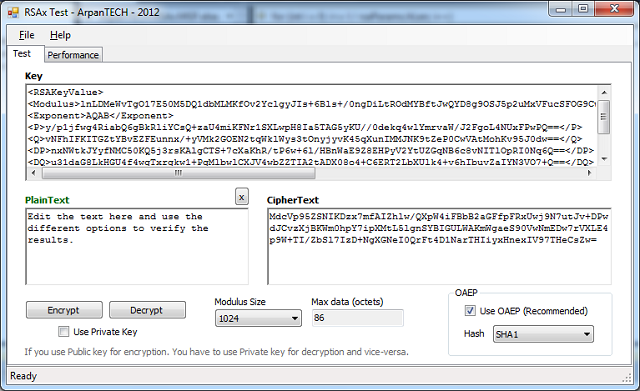Generate Rsa Private Key C#
CkRsa rsa; // Generate a 1024-bit key. Chilkat RSA supports // key sizes ranging from 512 bits to 4096 bits. // Note: Starting in Chilkat v9.5.0.49, RSA key sizes can be up to 8192 bits. // It takes a considerable amount of time and processing power to generate // an 8192-bit key. Bool success = rsa. C (Cpp) getRSAprivatekey - 1 examples found.These are the top rated real world C (Cpp) examples of getRSAprivatekey extracted from open source projects. You can rate examples to help us improve the quality of examples. I am trying to generate RSA keypair using openssl library and then read the same keys later. However, it fails. Sometimes it gives me this error. How to use public and private key encryption technique in C#. Ask Question Asked 6 years, 7 months ago. Browse other questions tagged c# encryption cryptography public-key-encryption private-key or ask your own question. Use RSA private key to generate public key? How does a public key verify a signature?
-->Asymmetric private keys should never be stored verbatim or in plain text on the local computer. If you need to store a private key, you should use a key container. For more information on key containers, see Understanding Machine-Level and User-Level RSA Key Containers.
To create an asymmetric key and save it in a key container
Create a new instance of a CspParameters class and pass the name that you want to call the key container to the CspParameters.KeyContainerName field.
Create a new instance of a class that derives from the AsymmetricAlgorithm class (usually RSACryptoServiceProvider or DSACryptoServiceProvider) and pass the previously created CspParameters object to its constructor.

To delete the key from a key container
Create a new instance of a CspParameters class and pass the name that you want to call the key container to the CspParameters.KeyContainerName field.
Create a new instance of a class that derives from the AsymmetricAlgorithm class (usually RSACryptoServiceProvider or DSACryptoServiceProvider) and pass the previously created CspParametersMicrosoft visio 2016 product key generator. object to its constructor.
Set the PersistKeyInCSP property of the class that derives from AsymmetricAlgorithm to false (False in Visual Basic).
Call the Clear method of the class that derives from AsymmetricAlgorithm. This method releases all resources of the class and clears the key container.
Example
Openssl generate key from pfx. The following example demonstrates how to create an asymmetric key, save it in a key container, retrieve the key at a later time, and delete the key from the container.
Notice that code in the GenKey_SaveInContainer method and the GetKeyFromContainer method is similar. When you specify a key container name for a CspParameters object and pass it to an AsymmetricAlgorithm object with the PersistKeyInCsp property or PersistKeyInCsp property set to true, the following occurs. If a key container with the specified name does not exist, then one is created and the key is persisted. If a key container with the specified name does exist, then the key in the container is automatically loaded into the current AsymmetricAlgorithm object. Therefore, the code in the GenKey_SaveInContainer method persists the key because it is run first, while the code in the GetKeyFromContainer method loads the key because it is run second.
See also
The current OpenPGP standard uses key pairs with RSA, DH/DSS, and ECC asymmetric encryption keys. In this chapter, we are going to generate an RSA key pair with DidiSoft OpenPGP Library for .NET.
Each OpenPGP key pair contains additional information which we have to specify upfront:
- User ID of the key owner, usually in the form “Person name or Organization name <owners_email@website>“
- Size in bits of the encryption key (must be over 1024 and up to 4096)
- list of preferred symmetric encryption algorithms
- list of preferred hash algorithms
- list of preferred compression algorithms
- key expiration date (if the key will be with a time-limited use)
The original PGP(r) software uses a naming convention for delimiting the email in the User ID label with < and > like: “Richard C. <richard.c@site.com>”
Generate RSA based OpenPGP key pair
Below is a short example program that shows how to generate an RSA OpenPGP key pair in a KeyStore object.
C# example
VB.NET example
The above code generates a key pair that does not expire. An overloaded method exists that accepts an expiration date as the last parameter. A key pair can also be generated without using a KeyStore, through a similar method in the PGPKeyPair class.
After the key pair is generated it can be exported. Usually, we will send the public key part of it to our partners.
Below is a screenshot of the key properties after the key is imported in PGP (r) Desktop version 10. Please note that in our example above we have omitted the < > around the email part of the User ID and that’s why PGP(r) displays the name and email part of the User ID together.
Async support
In order to create a key pair asynchronously, we have to use the DidiSoft.Pgp.KeyStoreAsync class which provides the same key creation methods with Async suffixes.
Summary
In this chapter, we have discussed RSA OpenPGP key generation with DidiSoft OpenPGP Library for .NET.

You may also consider reading DH/DSS OpenPGP key pair generation, ECC key pair generation, keys exporting and importing.
Example application
In the library installation folder under the Examples subfolder, you can find the project KeyToolCS (KeyToolVB for VB.NET), a demo WinForms application that illustrates OpenPGP key generation as well as many other operations that can be performed over OpenPGP keys.
C# Rsa Generate Private Key
List of methods used:
Begin Rsa Private Key
KeyStore.GenerateKeyPair
KeyStore.GenerateRsaKeyPair